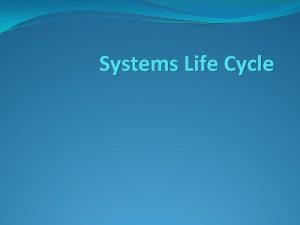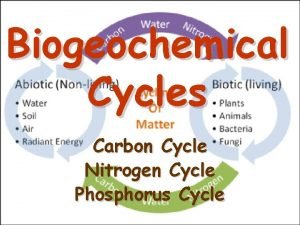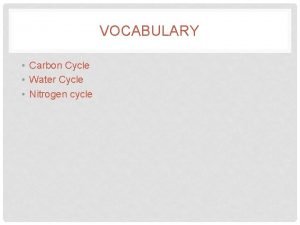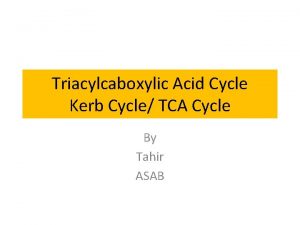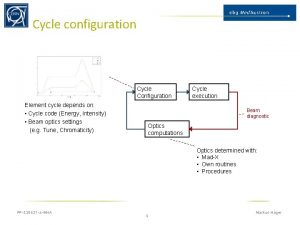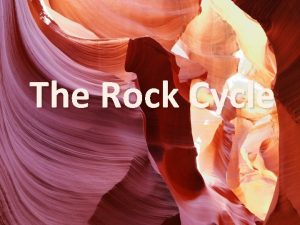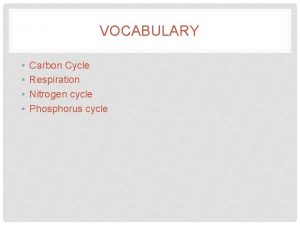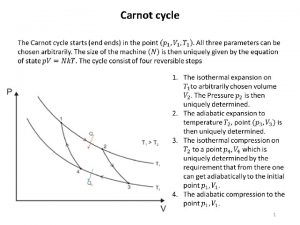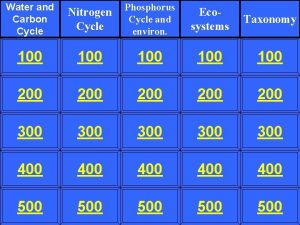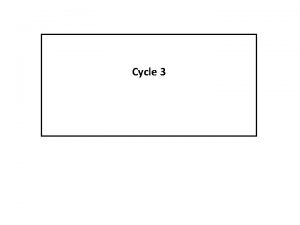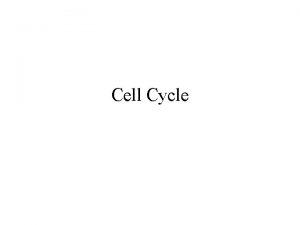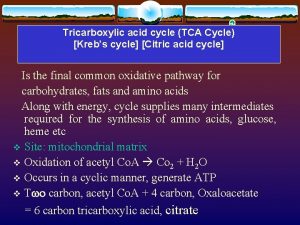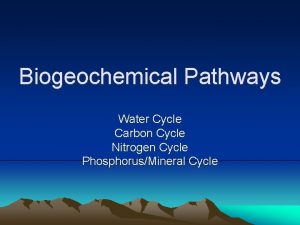Energy Cycle Energy systems What is the Energy

























- Slides: 25

Energy Cycle Energy system’s

What is the Energy cycle and what is its purpose? The energy cycle is the movement and exchange of energy into and out of the Earth’s systems (spheres). The energy cycle is located in the Atmosphere, Biosphere, Hydrosphere, and Lithosphere (every ‘sphere’ on Earth). The cycle is responsible for heating the Earth through sunlight, helping plants perform photosynthesis, the moving of water tides through the gravitational pull of the moon, and the heating of Earth through it’s core and crusts.

The Energy Cycle

Energy within the Atmosphere The energy entering and leaving the Earth’s Atmosphere is solar radiation. Solar radiation enters through the Ozone Layer; 50% of it is then absorbed into the Earth, 15% is absorbed by dust and molecules, 3% is absorbed by clouds, and 0. 023% of it is used for photosynthesis. Earth also reflects solar energy back through the Ozone Layer and into space. 5% of solar energy is reflected back into space randomly, 21% is reflected by clouds, and finally the ground reflects the remaining 6%. This solar energy is used to heat the Earth and life would not be possible with out it.


Energy within the Biosphere The energy located in the Biosphere is the exchange of solar energy with green plants and some other organisms to synthesize foods from carbon dioxide and water. This exchange of energy is called photosynthesis. After the plants complete photosynthesis they release Oxygen back into the atmosphere and better the Earth’s air (by diluting polluted air).


Energy within the Hydrosphere The energy located in the Hydrosphere is the gravitational pull of the moon and the sun that creates tides on the Earth. The moon is responsible for 56% of the Earth's tidal energy, while the sun is responsible for the other 44% (due to the close proximity of the moon and the sun’s much larger size). An entire ocean can be pulled by the moon’s gravity.

How it works…

Energy within the Lithosphere The energy located in the Lithosphere is the Earth’s core and crusts heating the Earth, it’s waters, and the Atmosphere. The heat from the Earth's core is always flowing outwards (towards the Earth’s surface). That heat moving outwards transfers heat and energy to the surrounding layers of rock. When the temperature and pressure becomes high enough in the rock it melts and becomes magma. Then because magma is lighter than the surrounding rock, the magma rises even closer towards Earth’s surface, carrying the heat with it and warming the Earth. Sometimes cracks in the Earth’s crust will form, and the hot magma or very hot water and steam can get to the surface. When magma reaches the surface it is known as a volcano. When hot water and steam reaches the surface it is known as a geyser (or hot spring).

The Lithosphere

Why is the Energy Cycle within Earth’s Systems Important? The energy cycle within Earth’s systems is the most important cycle the planet needs to survive. Without the energy cycle, plants and animals (including humans) would not be able to survive. Plants would not be able to grow because they need the sun’s energy to perform photosynthesis. Animals would not be able to live because the plants would start dying and eventually there would be no food left for anyone to eat; plus the Earth would not be warmed by the sun’s energy or Earth’s core’s energy, and life would not be able to exist in the cold climate that Earth would have if the sun or core energy weren’t there. No other cycles or systems would be able to work properly on Earth if the energy cycle within Earth’s systems did not exist.

Examples of this cycle -Solar flares: the solar energy cycle starts with the sun. Earth receives only a fraction of the energy released by the solar storms, and 30% of what we do get is reflected back into space -Tidal waves: tidal waves are part of the tidal energy cycle. It powers about 0. 002% of the earth, but it’s strong enough to slow the earth’s rotation -heat vents: Heat vents are a visible representation of geothermal energy in actionenergy from the earth’s core. This cycle powers volcanos, geysers and earthquakes.

The consequences of interrupting the cycle The problem with the energy cycle is that we as humans have interfered with it. In theory, the input of energy being absorbed into the earth via light and heat should equal to the amount that leaves the earth’s atmosphere. But recently the problem is that greenhouse gasses are causing the output of earth’s energy to go down. This means that the amount of heat the earth is taking into its atmosphere does not equal the amount leaving. Therefore the earth’s atmosphere is heating up. This is the cause of global warming and is causing sea levels to rise due to the melting ice caps.

Impact of human activity -Because of the pollution and greenhouse gases humans have released into the atmosphere via automobiles, factories releasing harmful pollutants and many other things. The ozone layer has become thinner and has even completely disappeared in some areas. This allows more UV rays to enter the atmosphere while more greenhouse gases are replacing areas where the atmosphere used to exist. A great example of this is over the arctic circle and Antarctica. The polar ice cap reflects over 90 percent of the sun rays that hit it and absorb the rest, and would normally have a portion of the sun rays bounce off the atmosphere and bounce back to earth to be absorbed, and the other portion would go back into space.

• But now instead of having that happen, the sun rays just get trapped beneath the green house gases causing the overall temperature to slowly increase. And as sun rays enter the atmosphere, and have no where to deposit the sun rays that would originally go back into space, they continue to hit the ice and therefore speeds up the natural melting process of the ice and causes it to slowly melt without being replenished. • Therefore the earth is keeping in much more sun rays within the atmosphere than it used to and a result has caused a global increase in temperature. This also causes wind currents and ocean currents to become stronger, and stray away from their usual pattern(to a certain extent) ie. More powerful hurricanes.

Effects on the economy (Solar energy)

Advantages of solar energy Its clean and safe Doesn’t require any fuel Its never going to run out Non-polluting Environmentally friendly It is renewable (unlike gas, oil and coal) and sustainable, helping protect our environment It doesn’t pollute our air by releasing carbon dioxide, nitrogen oxide, sulphur dioxide or mercury into the atmosphere

Disadvantages of solar energy Costs a lot of money The efficiency relies on good location The production of solar energy is influenced by the presence of clouds or pollution in the air

Environmental Effects ALBEDO the percentage of incoming solar radiation that is reflected by earth’s surfaces without being changed


Example 1: In areas where there is think snow or ice cover during the winter is the time when more of the suns energy would be reflected thus a higher albedo If the ice melts the water will absorb the suns rays Causing a temperature change in the water Animals and wildlife would have a hard time adapting to this new environment

Example 2: If a forest is cut down and replaced with houses, that area will reflect more energy back into the atmosphere opposed to absorbed The alterations in the energy cycle based off the transformations in the landscape are examples of how the earth system affects other parts Eg. Ecosystems, plants, animals, photosynthesis

What are we doing to save the cycle In order to save Earths energy cycle we need to have a balance of energy entering the system and being removed from the system. If more energy is taken in than released the climate will become warmer causing a global warming affect. Ways we are helping the energy cycle is by creating energy from wind turbines and increasing the amount of solar power we use. This benefits earth because these solutions don’t pollute the atmosphere or environment and don’t affect the energy cycle. Therefore reducing the chance of global warming.

Bibliography
 Hát kết hợp bộ gõ cơ thể
Hát kết hợp bộ gõ cơ thể Frameset trong html5
Frameset trong html5 Bổ thể
Bổ thể Tỉ lệ cơ thể trẻ em
Tỉ lệ cơ thể trẻ em Chó sói
Chó sói Tư thế worm breton
Tư thế worm breton Alleluia hat len nguoi oi
Alleluia hat len nguoi oi Môn thể thao bắt đầu bằng chữ f
Môn thể thao bắt đầu bằng chữ f Thế nào là hệ số cao nhất
Thế nào là hệ số cao nhất Các châu lục và đại dương trên thế giới
Các châu lục và đại dương trên thế giới Công của trọng lực
Công của trọng lực Trời xanh đây là của chúng ta thể thơ
Trời xanh đây là của chúng ta thể thơ Mật thư tọa độ 5x5
Mật thư tọa độ 5x5 Làm thế nào để 102-1=99
Làm thế nào để 102-1=99 độ dài liên kết
độ dài liên kết Các châu lục và đại dương trên thế giới
Các châu lục và đại dương trên thế giới Thể thơ truyền thống
Thể thơ truyền thống Quá trình desamine hóa có thể tạo ra
Quá trình desamine hóa có thể tạo ra Một số thể thơ truyền thống
Một số thể thơ truyền thống Cái miệng bé xinh thế chỉ nói điều hay thôi
Cái miệng bé xinh thế chỉ nói điều hay thôi Vẽ hình chiếu vuông góc của vật thể sau
Vẽ hình chiếu vuông góc của vật thể sau Thế nào là sự mỏi cơ
Thế nào là sự mỏi cơ đặc điểm cơ thể của người tối cổ
đặc điểm cơ thể của người tối cổ Thế nào là giọng cùng tên
Thế nào là giọng cùng tên Vẽ hình chiếu đứng bằng cạnh của vật thể
Vẽ hình chiếu đứng bằng cạnh của vật thể Vẽ hình chiếu vuông góc của vật thể sau
Vẽ hình chiếu vuông góc của vật thể sau




























